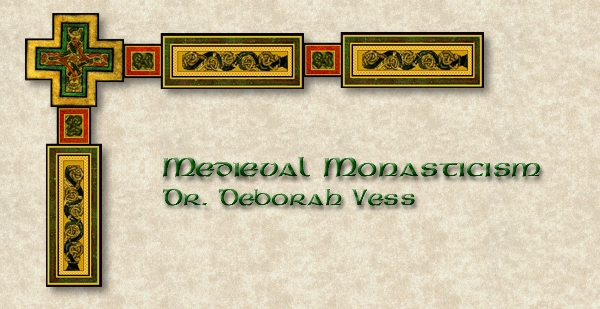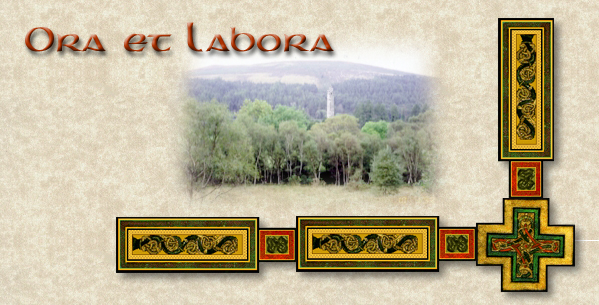
The Franks, the Church, and Monasticism
Objectives:
1. Be able to discuss the introduction of Christianity into the Kingdom of the Franks.
2. Be able to discuss the life and career of Genevefa, Virgin of Paris, as portrayed in the hagiography assigned.
3. Be able to discuss the social role and power of woman as portrayed in the Life of Genevefa, as well as in the lives of Clotild and Radegund.
4. Be able to discuss early monastic rules in the Kingdom of the Franks, in particular the Rule of Caesarius of Arles.
5. Be able to discuss the conversion of Clovis and the role of Clotild in that conversion.
6. Be able to discuss the portrayal of Clotild in the hagiography assigned for the session.
7. Be able to discuss how the portrayal of Clotild in Gregory the Great's History of the Franks differs from that in the hagiography.
8. Be able to discuss the foundation of women=s communities, such as Arles and Poitiers, and to explain the nature of the monastic rules used within the Kingdom of the Franks.
9. Be able to discuss the patters of composition of monastic rules in the Merovingian era as seen in the Rule of Donatus.
10. Be able to discuss the life and career of Radegund of Poitiers, her writings, and her influence.
11. Be able to discuss the lives, roles, and influence of women under monasticism in the Merovingian period.
Quotations:
"We have culled spiritual and holy injunctions for you from the ancient fathers; with God's help, may you be sheltered, and dwelling in the cells of your monastery, seeking in earnest prayer the presence of the Son of God, may you say in faith,'we have found him whom we sought.' Thus may you be of the number of holy virgins devoted to God, who wait with tapers alight and a calm conscience, calling upon the Lord. Since you are aware that I have worked towards establishing this monastery for you, let me be one of you through the intercessions of your prayer." The Rule of Caesarius of Arles
"She was always favorable to peace and interested in the weal of the realm whatever changes befell ... If she heard that they [the kings] were fighting, she felt troubled; and she appealed to them in writing, sometimes to one, sometimes to another, in order that they should not fight and war together, but keep peaceful, so that the country might rest securely." The Life of Radegund by Fortunatus
"To whom, mother, hast thou left us orphans? To whom then shall we turn in our distress? We left our parents, our relatives, and our homes, and we followed thee. What have we before us now, but tears unceasing, and grief that never can end? Verily, this monastery is to us more than the greatness of village and city ... The earth is now darkened to us, this place has been straightened since we longer behold thy countenance. Woe unto us who are left by our holy mother! Happy those who left this world whilst thou wast still alive..." The sisters of Poitiers upon the death of Radegund, according to Gregory of Tours
"Nothing shall prevent us from appealing to the kings, to them we are nearly related.... Do not use force of arms against me, I am a queen, daughter to one king and cousin to another. Do not attack me, a time will come when I will take my revenge!" Words of Chrodield during the rebellion at Poitiers, according to Gregory of Tours
Bibliography:
Primary Sources:
Two Lives of Radegund, her poem to her cousin, Lives of Clotild, Genevefa, Burgundofara, and Sadalberga in McNamara, ed. and trans., Sainted Women of the Dark Ages. Durham, N.C.: Duke University Press, 1992.
Lewis Thorpe, ed. Gregory of Tours: History of the Franks. New York: Penguin Books, 1983.
Secondary Sources:
Lina Eckenstein. Woman under Monasticism. New York: Russell and Russell, 1896.
A dated, though still very useful, overview of women's monastic history. The classic in the field before McNamara's text.
Penelope Johnson. Equal in Monastic Profession: Religious Women in Medieval France. Chicago: University of Chicago Press, 1991.
Jo Ann Kay McNamara. Sisters in Arms. Cambridge: Harvard University Press, 1996.
See the chapters on the Frontier, and Power of Prayer, The Bonds of Castimony, and Family Ties.
----- "Living Sermons: Consecrated Women and the Conversion of Gaul." Lillian Shank, ed. Peace Weavers. Kalamazoo: Cistercian Publications, 1987.
Suzanne Wemple. "Female Spirituality and Mysticism in Frankish Monasticism: Radegund, Balthild, and Aldegund." Lillian Shank, ed. Peace Weavers. Kalamazoo: Cistercian Publications, 1987.
----- Women and Frankish Society: Marriage and the Cloister, 500-900. Philadelphia: University of Pennsylvania Press, 1981.
OUTLINE
I. The Franks: General Background
A. The Laws of the Franks as compared to Roman Law
i. The Blood Feuds of the Franks
a. One's kin and the sins of the parents
b. Clotild and the sons of her uncle
i) examination of primary source from Gregory of Tours
c. Childebert and Amalric
d. Guntram and his niece Ingundis
e. Galswintha, Brunhild, Chilperic, and Fredegund
f. Radegund's poem: primary source portrait of violence
g. Development of the Wergeld
B. Christianity and the Franks
i. Some general remarks
a. Monasteries built upon the ruins of the pagan past
b. St. Martin of Tours
ii. Arian Christianity and Catholic Christianity
a. The conversion of Clovis
b) Clotild
c) discussion of her Carolingian hagiography
d) her portrait in Gregory of Tours
II. Women under Monasticism in the Merovingian Era
A.The Rule of Caesarius and the importance of Arles
i. Caesaria
ii. Children
iii. Class
iv. Chanting
v. contact with the outside world
vi. Synod of Agde in 506: no veil before 40
vi. Letter to Pope Hormisda
B. Mixed Rules: The Rule of Donatus
C. Genevefa and the power of women
D. Radegund of Poitiers
i. Location
ii. Sources:
a) Gregory the Great
b) Fortunatus
c) Baudonivia
d) Radegund's own writings
iii. Her parentage
iv. Clothar
a) reflections of life as a woman in Merovingian times
b) polygamy
v) murder of her brother
vi) Bishop Medard
vii) Germanus
viii) Poitiers
a) Agnes as abbess
b) Rule of Caesarius
c) during conflict between Sigebert, Chilperic, Brunhild, and Fredegund
d) her influence
ix) Fortunatus
x) Her death according to Gregory
E. The Rebellion at Poitiers
i) Basina
ii) Leubover
iii) Chrodield
iv) Childebert and Gondegisel
v) the outcome
F. Baudonivia's portrait: some reflections
G. Ingetrud of Tours
i) Berthegund
ii) Childebert and Gregory
H. Some final reflections:
i) monasteries and the political and social systems of the Merovingians: property
a) Fara and Louvres
b) Sadalberga
c) Family Dynasties in the Monasteries
ii) social class
a) Radegund after death
iii) Women and Violence
a) Rictrude and Eusubia
III. Reforms for Women
A. Council of Tours in 567 C.E.
B. Second Council of Tours
C. Clothacar II's reforms
Photo by Dr. Vess.
